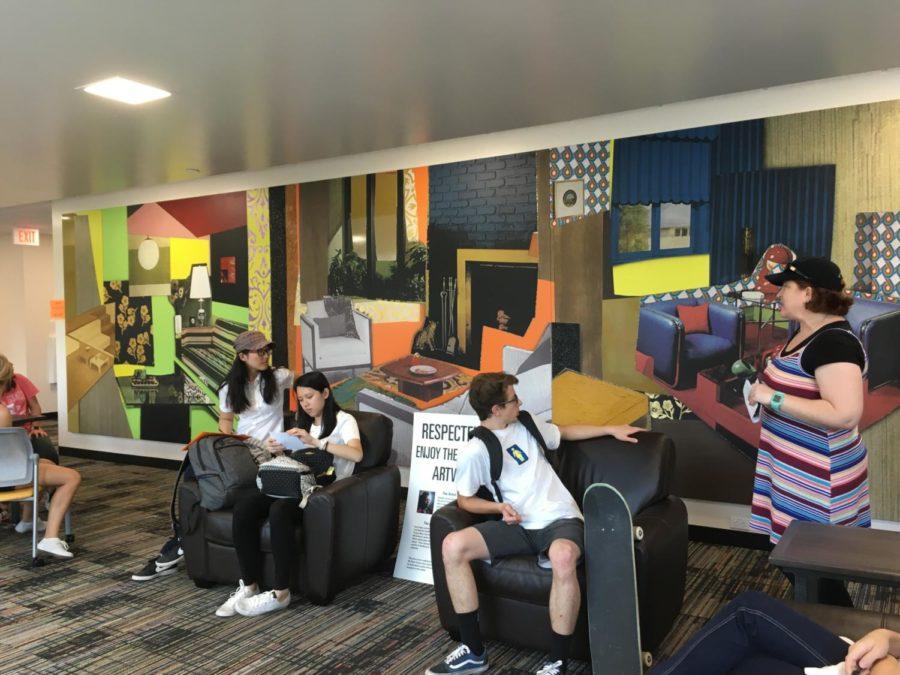New Geoffroy Hall art defines “home” for ISU students
August 29, 2017
For most college students, a residence hall is the first place they call home. It’s where students stay up until 2 a.m. studying for their exams, meet their lifelong friends, and gain new insight and perspectives on what home means to others. This year in Geoffroy Hall, an new art piece depicts the diverse perspectives of “home” for Iowa State University students.
The untitled work, which was installed in early August before students moved in, was created by Mickalene Thomas, an artist based in Brooklyn, New York. Thomas is nationally and internationally recognized in the art world, and her popularity has steadily risen since being commissioned nearly 2 years ago. Thomas’ work focuses on beauty and womanhood, and has been featured on the FOX television show “Empire”.
“She wasn’t as well-known as she is now, and her art has really grown,” said Erin O’Malley, campus outreach coordinator for University Museums
“[Thomas] was a very forward thinking selection,” said Brittney Rutherford, marketing coordinator for the Department of Residence. “It’s exciting to have gallery-quality pieces that students can interact with whenever they want.”
Evan Harrison, a senior in architecture at Iowa State, was selected to intern at Thomas’ studio in Brooklyn, New York for one week this summer to help with the project. As an architecture major with the College of Design, Harrison knew he was interested in the art project.
“I worked as a CA for two years and they wanted a community aspect, so it was like the two worlds of mine were colliding,” Harrison said.
When he met Thomas for the first time, he described her as, “one of the most fun, outgoing, eccentric people I’ve ever met.”
“She was in the zone, pulling things apart and together in a collaged way. Everything had a backstory,” Harrison said.
While Harrison was in Brooklyn, he worked with Thomas’s team of artists on screen printing, Photoshop, synthetic clay, and acrylic painting. He will speak on his experiences in a lecture at a later date this year.
The piece depicts five different interior living rooms, and each living space is a collage of different visual mediums.
Some pieces of the art are screen printed, gemstones and rhinestones outline other elements, and enamel and clay create different textures. The design is based on 1970s catalogs and portrays a vintage, idealized version of an urban living space.
“You don’t see any people, it’s just an interior. You become part of the artwork,” O’Malley said during Wednesday’s art walk.
During the art walk, students got the chance to interact with the work in person.
“It reminds me of college,” remarked one student. “There’s even a bowl of potato chips right there on the table.”
The work was commissioned to comply with Iowa’s Art in State Buildings Act, which requires public buildings to use one-half of one percent of the building’s budget to commission fine art. The piece is located on the first-floor lounge of Geoffroy Hall, and is still considered public art despite being located within the residence hall.
When the process began, a committee from the Department of Residence formed and began brainstorming ideas for concepts for the mural. Eventually, they came up with an art statement that defined the vision of the Department of Residence, focusing on themes such as unique perspectives, different textures, and dynamic community.
“We serve students from across the world, and what looks like home to me might look different from what home looks for you. These interiors reflect something, and they emote different feelings,” Rutherford said.
With this semester being Geoffroy Hall’s first semester at full capacity, Rutherford hopes the piece can contribute to the growing community and pride in the residence hall.
“I hope it creates a space where they do feel welcome,” Rutherford said.
“When it’s 1 a.m. and a student is studying, they can look over at the piece and think, ‘Oh, that lamp looks like the one at my grandma’s house and then go back to studying. You can interpret it in very different ways.”















